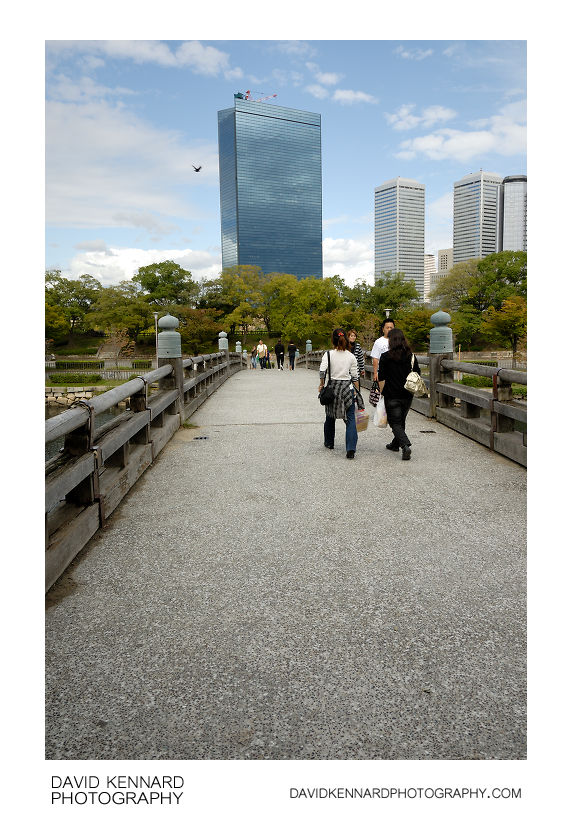Gokuraku-bashi and the Crystal Tower

Description
- Title:
- Gokuraku-bashi and the Crystal Tower
- Caption / Description:
-
The view north-east along Paradise bridge (極楽橋; Gokuraku-bashi) in Osaka Castle , Osaka, Japan. Osaka Castle (大坂城; 大阪城; Ōsaka-jō) was originally constructed by Toyotomi Hideyoshi in 1583. Gokuraku-bashi was built in 1626 as part of rebuilding works by Tokugawa Hidetada. The bridge crosses the inner moat (内濠; Uchibori), connecting the inner bailey (本丸; Honmaru) with the outer bailey (二の丸; Ninomaru).
The bridge was burnt down in 1868 after the castle fell to troops loyal to the Emperor in the Meiji Restoration. The current bridge dates from 1965, and is 54m wide by 5.4m wide, wider than the previous bridge's width of 3m. The modern bridge however, is constructed from reinforced concrete rather than wood.
Beyond the bridge, to the north of Osaka Castle, is the Osaka Business Park (大阪ビジネスパーク; Ōsaka bijinesu pāku). The most striking building in the business park is the Crystal Tower (クリスタルタワー; Kurisutaru tawā), a 157m tall glass covered skyscraper. The building contains 37 floors above ground level with 2 basement floors, and was completed in 1990.
To the east of the Crystal Tower is Twin 21 (ツイン21; Tsuin 21), two towers also known as the Osaka Twin Towers (大阪ツインタワー; Ōsaka tsuin tawā). The left tower was originally called the National Tower (ナショナルタワー; nashonaru tawā), but is now usually known as the OBP Panasonic Tower (OBPパナソニックタワー; OBP panasonikku tawā) as it is occupied by Panasonic. The right building is known as the MID Tower (MIDタワー; MID tawā) and is occupied by a variety of businesses.
The Twin 21 buildings rise to a height of 157m, with one basement floor and 38 floors above ground level. The first 4 floors of both buildings are connected together by an atrium. Building work started on the Twin 21 Towers in 1983, with completion in 1986.
- Tags / Keywords:
-
- Asia
- Japan
- 日本国
- Nihon-koku
- Kansai region
- 関西地方
- Kansai-chihō
- Osaka prefecture
- 大阪府
- Ōsaka-fu
- Osaka city
- 大阪市
- Ōsaka-shi
- Kinki region
- 近畿地方
- Kinki-chihō
- Chuo-ku
- 中央区
- Osaka Castle
- 大坂城
- 大阪城
- Ōsaka-jō
- Osaka Business Park
- 大阪ビジネスパーク
- Ōsaka bijinesu pāku
- Crystal Tower
- クリスタルタワー
- Kurisutaru tawā
- Twin 21
- ツイン21
- Tsuin 21
- Osaka Twin Towers
- 大阪ツインタワー
- Ōsaka tsuin tawā
- National Tower
- ナショナルタワー
- nashonaru tawā
- OBP Panasonic Tower
- OBPパナソニックタワー
- OBP panasonikku tawā
- MID Tower
- MIDタワー
- MID tawā
- Paradise bridge
- 極楽橋
- Gokuraku-bashi
- Inner moat
- 内濠
- Uchibori
- Outer bailey
- 二の丸
- Ninomaru
Admin
- Date Original Photo Taken:
- Original File Name:
- _DSC1145a.nef
- Event:
- Rating:
- ☆
- Date this image added/last updated on website:
- Original File Dimensions:
- 2475px x 3699px
- File Type:
- JPEG
- Color Mode:
- Original Image Color Profile:
- Nikon Adobe RGB 4.0.0.3001
Location
- Location Shown:
-
- Sublocation:
- Osaka Castle
- City:
- Osaka
- Province/State:
- Osaka prefecture
- Country:
- Japan
- World Region:
- Asia
- Location Created:
-
- Sublocation:
- Osaka Castle
- City:
- Osaka
- Province/State:
- Osaka prefecture
- Country:
- Japan
- World Region:
- Asia
- Geo-location:
- 34.688715, 135.52653666667 View on map
Rights
- Copyright Status:
- Copyrighted
- Licensing Status:
- Rights Managed
- Available for Editorial Use:
- Yes
- Available for Commercial Use:
- No
- Copyright Notice:
- © 2009 Dave Kennard
Camera Data
- Date Digital Resource was created:
- Shutter speed:
- 1⁄125 s
- Aperture:
- f/8
- Camera Model:
- Nikon D200
- ISO:
- 100
- Exposure Compensation:
- +1
- Focal Length:
- 18mm
- Focal Length (35mm equiv.):
- 27mm
- Metering Mode:
- Multi-segment
- Flash:
- No Flash
- Exposure Mode:
- Auto
- White Balance:
- Manual
- Light Source:
- Cloudy
- Exposure Program:
- Aperture-priority AE
Additional shooting metadata
- Lens:
- Nikon AF-S DX Zoom Nikkor ED 18-70mm F3.5-4.5G(IF)
- Filters used:
-
- B+W UV 010 MRC
- Additional Optics used:
- Setup:
- Handheld
Post Processing
- Image Modified:
- Software used:
-
- Nikon Capture NX 2
- Post Processing:
-0.3 exposure compensation in CNX2
Straightened in CNX2
Color Control Point used in CNX2 to brighten and add contrast
